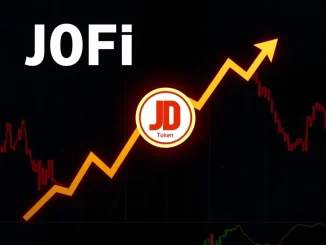
Exciting news for those watching the pulse of the network! Recent **on-chain data** analysis from Sentora (formerly known as IntoTheBlock) reveals a significant uptick in **Ethereum fees**. This jump indicates a healthy increase in usage and demand for block space on the blockchain.
Understanding the **Weekly Fees** Jump
Sentora reported via social media that the total **weekly fees** collected on the **Ethereum network** experienced a notable surge. The data shows a 12.2% increase, pushing the total weekly fees to $11.05 million. This isn’t just a minor fluctuation; it represents millions more dollars being processed and utilized within the network’s economy over a seven-day period.
To put it simply, when users interact with applications or transfer assets on Ethereum, they pay a small fee (gas) to validators to process their transactions. The sum of all these fees over a week provides a clear picture of overall network activity and demand.
**DeFi Activity**: The Key Driver Behind the Surge
According to Sentora’s analysis, the primary force propelling this increase in **Ethereum fees** is heightened **DeFi activity**. Decentralized Finance, or DeFi, encompasses a wide range of financial applications built on blockchain technology, including lending protocols, decentralized exchanges (DEXs), yield farming platforms, and more.
Why does increased **DeFi activity** lead to higher fees? Here’s a breakdown:
- Complex Transactions: DeFi interactions often involve multiple steps or smart contract executions (like swapping tokens, providing liquidity, or managing collateral). These complex operations consume more ‘gas’ compared to simple transfers.
- Increased Volume: More users engaging with DeFi protocols means a higher volume of these complex transactions competing for space in Ethereum blocks.
- Protocol Interaction: Every time you lend, borrow, stake, or trade on a DeFi platform, you’re executing a transaction on the **Ethereum network**, contributing to the total fee count.
The 12.2% rise in **weekly fees** strongly suggests that users are actively utilizing Ethereum’s capabilities for financial operations, highlighting the network’s role as a leading platform for decentralized finance.
Insights from **On-Chain Data**
The report from Sentora underscores the value of **on-chain data**. This data is publicly available information recorded on the blockchain itself – details like transactions, addresses, contract interactions, and fees paid. Analyzing this data provides transparent, real-time insights into network usage patterns that traditional financial markets often lack.
Firms like Sentora specialize in interpreting this vast amount of data, translating raw blockchain information into understandable metrics and trends. Their ability to pinpoint the increase in **Ethereum fees** and link it directly to **DeFi activity** offers valuable context for investors, developers, and users alike, showing exactly what’s driving demand on the **Ethereum network**.
Impact on the **Ethereum Network**
What does a 12.2% jump in **weekly fees** mean for the broader **Ethereum network**?
- For Users: While the total fee sum is up, it doesn’t automatically mean every transaction is drastically more expensive. However, increased demand often correlates with higher gas prices during busy periods, potentially impacting the cost of using DeFi applications.
- For Validators: Post-Merge, transaction fees are primarily burned, reducing ETH supply. However, priority fees (tips paid by users to speed up transactions) and MEV (Maximal Extractable Value) rewards still contribute to validator income. Higher overall fee activity suggests more potential revenue streams for those securing the network.
- Network Health: Increased fee generation driven by organic usage like DeFi is generally seen as a positive sign of a vibrant, active network. It demonstrates that there is real utility and demand for the services built on Ethereum.
The data points to a robust ecosystem where users are actively engaging with decentralized applications, willing to pay fees for the services provided by the **Ethereum network**.
Summary: A Boost for Ethereum Activity
In conclusion, the 12.2% rise in **Ethereum fees** to $11.05 million weekly, as reported by Sentora’s **on-chain data**, is a clear indicator of surging **DeFi activity**. This increase reflects growing utilization and demand for the **Ethereum network**, particularly within its Decentralized Finance sector. It highlights the network’s ongoing relevance and importance as a foundational layer for decentralized applications and financial innovation.



